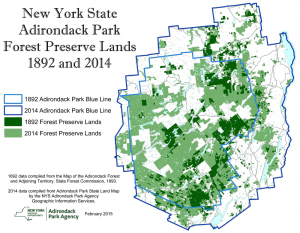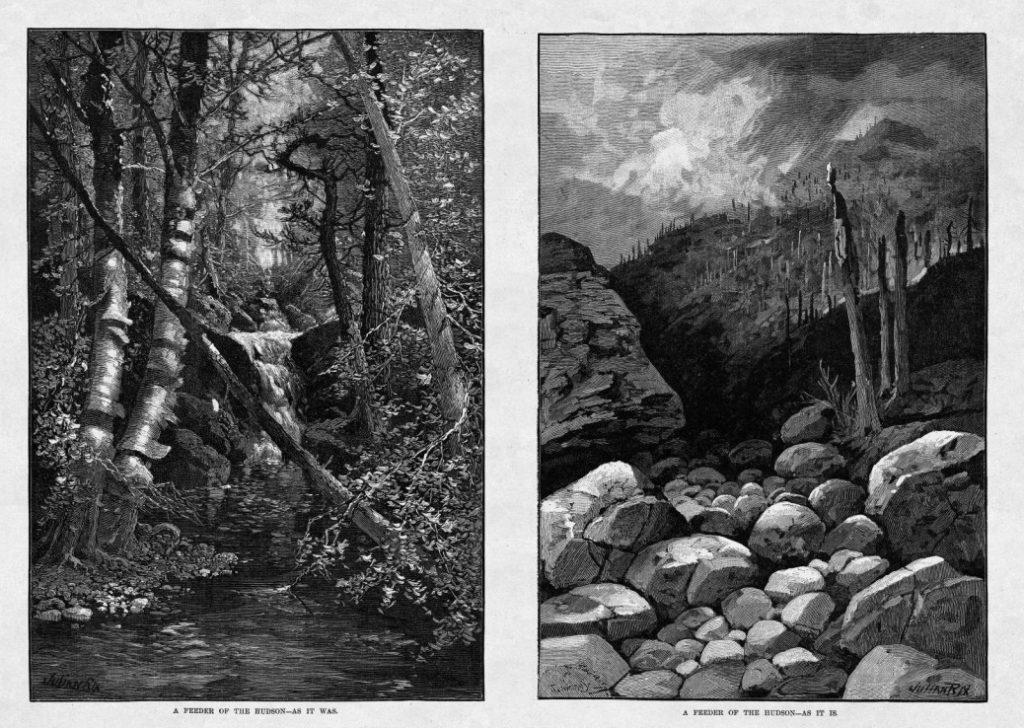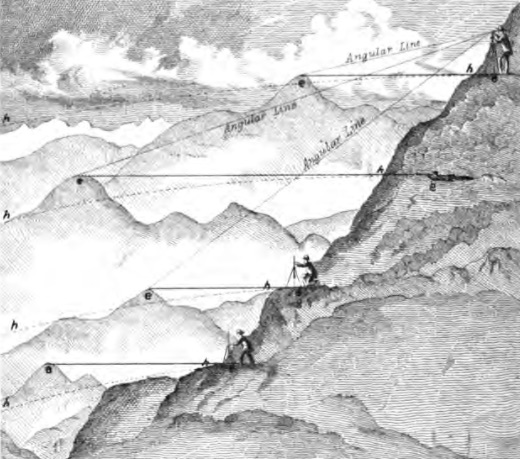The lands of the state, now owned or hereafter acquired, constituting the forest preserve, as now fixed by law, shall be forever kept as wild lands. They shall not be leased, sold, or exchanged, nor shall the timber thereon be sold, removed or destroyed.
– Article XIV, Section 1, New York State Constitution

In 1894, the New York State legislature approved a constitutional amendment, now known as Article XIV, which protected the state’s Adirondack Forest Preserve as “Forever Wild”. [ref] Article XIV, Section 1, New York State Constitution [/ref] The strict protection of state lands was certainly ahead of its time, and served as an inspiration and a model for the federal Wilderness Act which was not adopted until 1964. [ref] Zahniser, “An Adirondack Wilderness Imperiled.” [/ref] The amendment continues to have a major role in shaping how the 6,000,000 acre Adirondack Park (larger than Yellowstone, Yosemite, Grand Canyon, Glacier, and Great Smoky Mountains National Parks combined!) is managed and used. The Park contains roughly half public and half private land, including scattered small communities, several ski resorts and Olympics facilities, timber lands, and wilderness areas that protect many of the state’s natural and scenic landscapes in perpetuity. [ref] Porter et al., The Great Experiment in Conservation. [/ref]
While the efforts of several key individuals and groups in the late 19th century were important in the creation of such a monumental land preservation system, broad cultural trends set the stage for the legislative action of the 1890s. In the late 19th century, literary romanticism brought many wealthy, educated visitors from cities, especially New York, who desired a sense of intimacy with pristine and sublime landscapes. These privileged elites of New York society valued the Adirondacks for its aesthetic and spiritual characteristics, and brought money to the area where they hired local wilderness guides and built extravagant Great Camps for vacationing on remote lakefront properties. [ref] Terrie, Forever Wild. [/ref] The Commissioners of the Adirondack Park noted:
Throughout this forest, game is still abundant; the deer, bear and panther, with smaller animals, find shelter and support and their presence gives to the magnificent scenery a strange, wild and romantic element, which has contributed to make its more accessible portions a choice summer pleasure ground for those of our people who travel, and who admire the natural splendor of their native land. [ref] State of New York, First Annual Report of the Commissioners of State Parks of the State of New York : Transmitted to the Legislature May 15th, 1873. [/ref]
Simultaneously, the pristine qualities of the Adirondack mountains brought the interests of physicians to the area, where the “mountain cure” for illness—especially tuberculosis—became another important 19th century function of the Adirondack environment. [ref] Graham, The Adirondack Park.[/ref] For others, the utilitarian functions of the Adirondacks also made the region valuable, particularly its timber and water resources. Logging in the Adirondacks also intensified after the Civil War, when large companies began to harvest large amounts of timber for a growing downstate market as well as, in some areas, for charcoal production. By the 1890s, new technologies that produced paper out of wood pulp caused Adirondack loggers to begin clear-cutting timber for paper pulp at alarming rates. [ref] Terrie, Contested Terrain. [/ref] Additionally, downstate business people involved in commercial trade relied on the navigable waters of the Hudson and Mohawk valleys, especially the Erie Canal, which were fed by Adirondack headwaters. There were widespread concerns that logging in the Adirondacks could cause alternate floods and droughts (like the severe drought of 1883) due to forest cover loss, which could threaten transportation over these routes. [ref] Halper, “The Adirondack Park and Northern Forest: An Essay on Preservation and Conservation.” [/ref]

Left: “A feeder of the Hudson—as it was” Right: “A feeder of the Hudson—as it is.” Source: Harpers Weekly, 24 January 1885.
George Perkins Marsh was among the first to draw attention to the need for an Adirondack Park. As a former diplomat who had traveled in Europe, he drew parallels between New York and the civilizations of Greece and Rome where he believed that reckless timber cutting had caused them to fall. He expressed apocalyptic predictions for a nation clearing its forests, especially in the headwaters of the Hudson, and argued for conservation out of concern for the survival of American civilization. [ref] Jacoby, Crimes against Nature. [/ref] Others soon joined him in calling for conservation of the Adirondacks, especially Verplanck Colvin, the leader of the first large survey team in the High Peaks region which located the source of the Hudson close to the summit of Mt. Marcy. Colvin presented his findings to the legislature in the 1890s and pushed for a state conservation plan. Soon groups of sport hunters and commercial interests prodded the state to form a committee to look into establishing an Adirondack Park. In 1890, the state formed a Forest Commission to purchase new lands in the Adirondacks to add to the existing state holdings from foreclosed timber lands. Two years later, the state strengthened its commitment to preserving the Adirondacks through the “Forever Wild” clause. [ref] Terrie, Contested Terrain. [/ref]

Plan showing mountain measurement with barometer and spirit-level distances by triangulation. Source: Colvin, Annual Report on the Progress of the Topographical Survey of the Adirondack Region of New York.